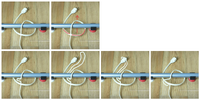You are using an out of date browser. It may not display this or other websites correctly.
You should upgrade or use an alternative browser.
You should upgrade or use an alternative browser.
Seeing's believing? See how you react to this logic-defying video.
- Thread starter JGeropoulas
- Start date
Topology is such a fascinating branch of mathematics. I think it's because it makes use of principles of mathematics that our monkey brains aren't evolved to intuitively grasp like we can with normal mechanics.
This is a breakdown of the mathematics used to resolve one topological puzzle. Trying to apply it to the above, it looks like they introduce threading and looping which is anti-wise to the original setup, and that allows the puzzle to become mathematically "trivial."

 scilogs.spektrum.de
scilogs.spektrum.de
This is a breakdown of the mathematics used to resolve one topological puzzle. Trying to apply it to the above, it looks like they introduce threading and looping which is anti-wise to the original setup, and that allows the puzzle to become mathematically "trivial."

Amazing Rope Trick
Here’s an amazing trick that Curtis McMullen performed in yesterday’s workshop on Quantum Mechanics and Topology, organized by Ryan Grady. McMullen modestly declined to be photographed, so here Grady demonstrates the trick. Step 1: Thread …
JGeropoulas
The Living Force
I suspected the process could be expressed and evaluated in mathematical terms, as your linked article explained in their example (BTW the linked site now omits the referenced pictures). But my "monkey brain" cannot intuit how ANY maneuvering of the string (e.g. looping it over the post) can circumvent the inescapable necessity of disconnecting the string from the post to free the ring. Maybe my monkey brain can grasp what's happening better if I build a model and watch the process carefully, then even try to do the reverse operation of putting the ring back on the string!Topology is such a fascinating branch of mathematics. I think it's because it makes use of principles of mathematics that our monkey brains aren't evolved to intuitively grasp like we can with normal mechanics.
This is a breakdown of the mathematics used to resolve one topological puzzle. Trying to apply it to the above, it looks like they introduce threading and looping which is anti-wise to the original setup, and that allows the puzzle to become mathematically "trivial."

Amazing Rope Trick
Here’s an amazing trick that Curtis McMullen performed in yesterday’s workshop on Quantum Mechanics and Topology, organized by Ryan Grady. McMullen modestly declined to be photographed, so here Grady demonstrates the trick. Step 1: Thread …scilogs.spektrum.de

Instead of lifting the ring over the pole, the thread is lifted over the pole while the ring is held in position - same effect.
JGeropoulas
The Living Force
Although 2 additional loops are placed around the post, the original loop of the cord around the post (and through the ring) is never detached from the post.Well he is removing the rope momentarily to loop it around the post. I think that sequence flips the ring to the outside of the rope where it can be removed.
JGeropoulas
The Living Force
Yeah, a Moebius strip was the only concept I could rally in trying to comprehend this puzzle.This reminds me of unintuitive geometry, such as the fact that the Moebius strip has only one surface. Cutting a Moebius strip also provides unintuitive results:
JGeropoulas
The Living Force
OK, I watched the video and now the conceptual gears in my brain are overheating. Of course now I want to know what happens if the original Moebius strip is cut into 3 strips. Predictions anyone?This reminds me of unintuitive geometry, such as the fact that the Moebius strip has only one surface. Cutting a Moebius strip also provides unintuitive results:

Wandering Star
The Living Force
Yes, it is like a sailor's knot in which the metal ring is attached to the stick on the outside thanks to the knot.Well he is removing the rope momentarily to loop it around the post. I think that sequence flips the ring to the outside of the rope where it can be removed.
When the knot is finished, the ring stays with it and when you pull the ring, the knot comes undone, the ring is released and the rubber remains apparently the same (apparently).
Sailor knots are fascinating and almost magical.
JGeropoulas
The Living Force
I'm generally pretty adept at grasping and applying concepts, but my mind's apparently missing the file for grasping how these ring/knot tricks could possibly work. Speaking of knots, I read of a research study related to the seeming phenomenon of cords tying themselves in knots. They place 2 strings in a tumbling device, then after each rotation, checked to see if the strings had knotted together. They repeated this process with progressively longer pairs of strings. Inevitably, at some point, the 2 strings tied themselves together!Me thinks knots are magic!
mrtn
Dagobah Resident
Maybe this picture helps:I'm generally pretty adept at grasping and applying concepts, but my mind's apparently missing the file for grasping how these ring/knot tricks could possibly work.
If the cable running to the bottom would not go through the bottom loop but outside it, then you could slide the whole thing upwards and the red bottom part would get free, right?
You can get there by putting a sling under the pipe and putting the plug through the sling on the other side, then get the sling back and voilà.
Not sure about the move of the guy in the video, but it shows it's possible.



